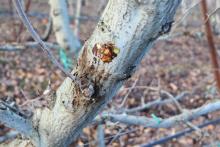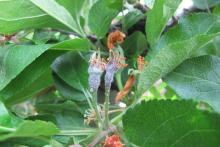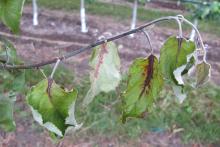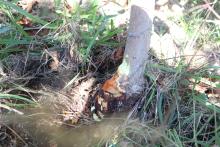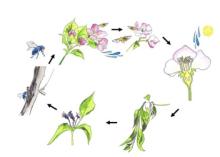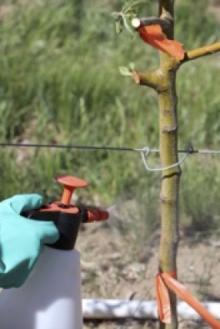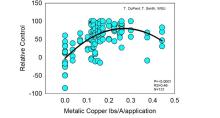In this section
Fire Blight of Apple and Pear
Fire blight is an important disease affecting apple and pear. Infections commonly occur during bloom or on late blooms during the three weeks following petal fall. Increased acreage of highly susceptible apple varieties on highly susceptible rootstocks has increased the danger that infected blocks will suffer significant damage. In Washington there have been minor outbreaks annually since 1991 and serious damage in about 5 to 10 percent of orchards in 1993, 1997, 1998, 2005, 2009, 2012, 2015, 2016, 2017 and 2018.
Casual Organism
Fire blight is caused by Erwinia amylovora, a gram-negative, rod-shaped bacterium. The bacterium grows by splitting its cells and this rate of division is regulated by temperature. Cell division is minimal below 50°F, and relatively slow at air temperatures between 50 to 70°F. At air temperatures above 70°F, the rate of cell division increases rapidly and is fastest at 80°F. Above 95°F cell density on and in the plant can actually decline .
Host Range
Considered a problem for apple and pear, E. amylovora has a wide host range within Rosacea and Rubus with reports on about 200 species including cotoneaster, crabapple, hawthorn, mountain ash, Bradford flowering pear, photinia, pyracantha and quince.
Symptoms and Signs
Overwintering cankers can appear black, grey, or violet (Figure 1). Older cankers may have dry sunken tissue. If the bark is cut from the edge of an active canker, reddish flecking can be seen in the wood near the canker margin .
Blossom symptoms become apparent one to two weeks after infection. The floral receptacle, ovary, and peduncles become water soaked and dull, grayish green in appearance (Figure 2). Later tissues shrivel and turn brown to black. During periods of high humidity, small droplets of bacterial ooze form on water-soaked and discolored tissues. Ooze droplets start creamy white, becoming amber tinted as they age.
Shoot symptoms. Shoot tips may wilt rapidly forming a “shepherd’s crook.” Leaves on diseased shoots often show blackening along the midrib and veins before becoming fully necrotic, and cling firmly to the host after death (a key diagnostic feature) (Figure 3). Numerous diseased shoots give a tree a burnt, blighted appearance. Hence the disease name.
Rootstock infections usually develop near the graft union as a result of internal movement of the pathogen through the tree or from infection of root suckers. The bark of infected rootstocks may show water-soaking, purplish to black discoloration, cracking, or signs of bacterial ooze. Red-brown streaking may be apparent in the cambium just under the bark (Figure 4). Symptoms of rootstock blight can be confused with Phytophthora collar rot. Malling 26 and 9 rootstocks are highly susceptible to fire blight.
Transmission and Disease Cycle
Erwinia amylovora overwinters in the living tissue around canker margins. In 7 to 62% of cankers, active cells survive the winter and when humidity is high in the spring the pathogen oozes out of these cankers (Figure 5). This ooze is attractive to bees, flies and other insects who transfer the blight pathogen to flowers. Pathogen cells can also be moved from old cankers to flowers by splashed and wind-blown rain. Pathogen cells multiply quickly on nutrient rich floral stigma when temperatures are warm (70 to 80° F is optimal for the pathogen). Bacterial cells can then be washed down the style into the floral cup by water (usually from rain or heavy dew) where they can invade flowers through the nectaries. Once initial blossoms are infested, ooze droplets form with as many as a billion bacterial cells per droplet. Insects and rain can move the pathogen to additional flowers. If the pathogen is successful in infecting the developing fruitlet, the disease spreads through the intercellular spaces and then the vascular system of the tree (xylem). It kills young host tissues as it progresses creating characteristic strikes and cankers. Pathogen cells migrate inside the tree well ahead of visible symptoms where they can accumulate in other susceptible tissue such as one-year old shoot tips and susceptible rootstocks causing infections distant from the original infection. For example, in a Michigan study, fire blight bacteria moved an average of 6 cm per day in new growth and 4 cm per day in woody growth in five-year-old Gala, which equates to approximately 11 inches per week.
Erwinia amylovora can also infect susceptible one- and two-year-old tissue directly through wounds (such as insect feeding and hail) and natural openings causing shoot blight infections.
Cultural Management
Plant on resistant rootstock. Resistant rootstocks (such as Geneva series for apples) do not make the scion less susceptible, but will help prevent tree death from rootstock blight.
Winter sanitation. In winter, prune out old blight cankers as thoroughly as possible. Ideally, cut blight before you prune for tree structure so that the blighted cuttings can be removed from the orchard. Compared to cuts made in summer, winter removal cuts can be made closer to the visible canker edge. In winter the pathogen is confined to the cankered area. Cut at the next “horticulturally sensible” site below the canker. You do not need to sterilize tools when you are cutting on fully dormant trees. Late dormant copper applications can enhance orchard sanitation, further reducing inoculum levels going into spring.
Manage the orchard environment. In addition to warm temperatures, moisture is required to initiate infections. As little as two to three hours of wetting from dew or light rain is sufficient to trigger infection. Manage weeds and cover crops to limit relative humidity. Do not irrigate during bloom.
Blossom removal in young blocks. Blossom removal in young blocks and removal of late blooms limits the numbers of flowers and thus reduces potential points of infection. In two 2020 trials flower removal at pink for young non-bearing trees reduced infections to 0 compared to 71-77 per 100 clusters in water treated checks and 5-17 per 100 clusters on trees treated with soluble copper.
Keep tree vigor moderate. Moderating vigor will not prevent infection, but it can reduce damage to the tree by limiting the amount of new and more susceptible plant growth.
Summer sanitation. Timely cutting of fire blight infected material soon after infections occur is recommended to reduce the spread of the pathogen throughout the orchard and to limit the advance of the disease in the tree, which can lead to plant death. Remove infected branches 12 to 18 inches below the visibly infected tissue into 2-year or older wood. Timely removal reduces the number of trees that die from fire blight. This practice reduces the number of new infections which must be removed after initial pruning.
Although sanitizing pruning shears has been long considered important to prevent dissemination of fire blight infections, in multiple studies sterilizing shears made no difference in preventing canker formation as long as the cuts are made at the recommended distance below the visible canker. Canker removal cuts made 2-3 inches from where the branch joins structural wood (stub cutting) can significantly reduce the number of cankers that re-develop on structural wood, which sustains fruiting area for future years. While small cankers will re-form on many of these cuts, these cankers can be removed during winter pruning. Breaking off infected flower clusters and diseased current season growth by hand can provide a rapid removal method, but it can result in a greater number of cankers in the orchard at the end of the season with more cankers on structural wood.
Applying a concentrated solution of Actigard as part of pruning therapies can reduce the severity of re-occurring fire blight cankers. In trees with Actigard applied when removing fire blight infection, both the proportion of trees in which fire blight re-occurred and the rate of canker expansion was reduced in five years of field trials. Apply concentrated Actigard in water with an up and down motion to a 2-foot section of the central leader or major scaffold near where the fire blight infection was removed.
In first to third leaf young trees infected trees should be removed and destroyed. In young vigorous trees, bacteria move quickly through the tree and pruning therapies are unlikely to be effective. Apply Actigard to remaining neighboring trees to reduce the risk of developing fire blight.
Temperature Risk Models
The risk of fire blight infections during bloom can be calculated based on the temperature and moisture. In Washington the best prediction model is Cougar Blight available at WSU Decision Aid System for Tree Fruit (DAS) - https://www.decisionaid.systems/. This model calculates fire blight risk based on the temperature of the previous four days using the documented growth rate of the bacteria. The model then projects risk for the next three days based on predicted temperatures. Growers can use model information to decide when to spray. If trees are likely to be blooming during an upcoming high-risk period, protective sprays are recommended.
Chemical Management
Chemical Management Programs
There is a risk of fire blight infection any time there are flowers on the tree, the weather is warm, and wetting occurs. Watch for and protect secondary blossoms during the three weeks after petal fall, a common time for fire blight infection. Most sprays only protect the blooms that are open. Protect new blooms as they open. In warm weather follow-up sprays are needed every 2 to 3 days rotating FRAC materials.
Conventional Management
Start by regularly watching a fire blight model. After a period of warm weather (high infection risk) best results are obtained when antibiotics are applied within the 24-hour window before flower wetting. Products used must contact the interior of the flowers in sufficient water and approved wetting agent to completely cover the interior. Antibiotic sprays every 2 to 3 days may be necessary during extended high or extreme risk periods. Rotate between materials with different modes of action (different FRAC groups). In high risk blocks or if fire blight was in the orchard last year, consider applications of Blossom Protect during early bloom. Lime sulfur applied for thinning is also antimicrobial and reduces blight pressure. See Tables 1 and 2.
Organic Management
Non-antibiotic control programs for fire blight which contain Blossom Protect and soluble copper products during the bloom period (such as Previsto or Cueva) followed by Bacillus based biorationals (such as Serenade) at petal fall have performed well suppressing fire blight infections with lower russet risk in Oregon Washington and New York trials. In difficult-to-thin apple varieties, with multiple lime sulfur applications, soluble coppers may fit better in management programs than Blossom Protect since its active ingredient is impacted by lime sulfur applications. Integrated programs with Blossom Protect and/or soluble coppers during high-risk bloom periods followed by essential oils or peracetic acid-peroxide products (such as Thyme Guard, Cinnerate, Oxidate, or Jet Ag) at petal fall have also had control similar to Blossom Protect/Serenade programs in several trials. Consider drying times, rotations, and limit post petal fall applications of essential oils and peracetic acid-peroxides products to moderate russet risk. See Tables 1 and 2.
Non-bearing trees
Young non-bearing trees with high vigor in high-risk varieties or locations may require season-long protection from shoot blight. In trials for protection of young non-bearing trees, flower removal performed best followed by weekly applications of either soluble or fixed copper. Flower removal at pink for young non-bearing trees reduced infections to 0 infections per 100 clusters in PA and 0 per 100 in New York in 2020 trials. Three applications of soluble copper reduced infections per 100 clusters from 77 to 5.5 in New York, and 71 to 17 in Pennsylvania and three applications of fixed copper reduced infections per 100 clusters from 77 to 27 in New York and 71 to 8 in Pennsylvania.
Antibiotic Resistance Management
Fire blight pathogen resistance to streptomycin was first detected in California in 1971 and in Oregon and Washington in the 1970s and 1980s . It was believed to be widespread in the western United States in 1991 and in other parts of the US including Idaho, Utah, Missouri, Michigan (2003) and New York (2002, 2016, 2021). In an ongoing survey in Washington none of the bacterial populations screened exhibited resistance to streptomycin, tetracycline or kasugamycin . To minimize the risk of resistance development, it is recommended to apply streptomycin in combination with oxytetracycline and limit streptomycin application to once per season. Kasugamycin could be applied in a mixture with oxytetracycline or rotation with oxytetracycline.
Strategies for Improving Protective Programs
Coverage
Product efficacy is based on thorough coverage of flowers. Use tree row volume to apply appropriate volumes to cover the tree architecture in your orchard. Products applied every other row or at high speeds will result in insufficient coverage and lower efficacy.
Timing
Antibiotics have the highest efficacy when applied shortly before a moisture event. Kasugamycin and streptomycin can also be applied up to 12 hours after a moisture event, but with reduced effectiveness. Streptomycin has locally systemic activity and kasugamycin is effective on bacteria which have been washed into the floral cup but not yet invaded the flower.
pH of Spray Tank Water
It is important to appropriately acidify spray tank water when using antibiotics (especially oxytetracycline and kasugamycin). Antibiotic efficacy reported in WSU trials is with spray tank water buffered to pH 5.6. At higher pHs antibiotic degradation rate is faster and thus efficacy is often lower. For example, in one trial kasugamycin reduced the bacterial population by 86% to 96% at pH 5.1 but only 21% to 35% at pH 7.3. Buffering oxytetracycline products to a pH of 4 can further improve efficacy.
Use Appropriate Rates
Quantity of active ingredient is important to obtain efficacy. For example, recent work looking at rates of copper products demonstrated that as metallic copper content increases, copper product efficacy increases up to approximately 0.2 lb. metallic copper per 100 gal per acre (Figure 8). This is equivalent to approximately 3 qt. of Previsto or 4 qt. of Cueva.
Mixtures
A full rate of kasugamycin (100 ppm) with a full rate of oxytetracycline (200 ppm), as well as streptomycin (100 ppm) mixed with a full rate of oxytetracycline (200 ppm) have provided improved efficacy in some trials (Oregon 2015-2018). Actigard plus an antibiotic applied during bloom has improved the efficacy of antibiotics an average of 5% to 6% per ASM treatment in trials in Washington and Oregon.
Antibiotics
Kasugamycin (Kasumin) is a recently labeled antibiotic that provides excellent levels of control. For example in eight trials in Michigan relative control averaged 92%. All fire blight strains are currently sensitive to this material but there is an intermediate risk of resistance developing to this antibiotic. Kasumin controls streptomycin-resistant strains of fire blight. Kasumin provides forward control for two to three days prior to rain events (on flowers open when applied) and will be partially effective for blossom blight control if applied within 12 hours after a rain event. Kasumin is not locally systemic like streptomycin. Thus, Kasumin will not penetrate into the nectaries and will not be able to control an infection once the fire blight pathogen reaches the nectaries. Acidifying spray tanks (target 5.0) is important to reduce antibiotic break down and extend activity. Kasugamycin is ultraviolet (UV) sensitive and spraying at night and reduced pH can help improve residual time. The use of a non-ionic surfactant enhances deposition of the antibiotic on flowers.
Oxytetracycline (Mycoshield, FireLine) generally provides good levels of control in Washington trials (average 74% control) and has a low risk of resistance development. Oxytetracycline products should be applied within 12 to 24 hours prior to a moisture event for best results. Oxytetracycline is considered bacteriostatic (inhibits bacterial growth but does not kill them). Thus, to be effective it must be applied prior to rains where it can prevent growth on stigmas. Oxytetracycline is also sensitive to UV degradation and much of the activity is lost within one to two days after application. Acidifying spray tanks (target 5.0) is important to reduce antibiotic break down and extend activity. The use of a non-ionic surfactant enhances deposition of the antibiotic on flowers.
Streptomycin (Agri-Mycin, FireWall): Streptomycin-resistant strains of the fire blight pathogen have been present in Washington orchards since 1975. Recent tests have indicated that the proportion of the pathogen population resistant to this antibiotic has dropped and expected control levels have improved. In an ongoing survey in Washington no fire blight strains resistant to streptomycin were detected. This product should only be used in combination with oxytetracycline and should not be used unless a high-to-extreme risk infection period is expected. Limit use to once per season. The use of a non-ionic surfactant enhances deposition of the antibiotic on flowers. Acidifying spray tanks (target 5.0) is important to reduce antibiotic break down and extend activity.
Non-Antibiotic Products
In summary analysis of eight Washington trials Alum (potassium aluminum sulfate), Blossom Protect (A. pullulans) and several copper products (Previsto, Mastercop, Instill) provided good disease suppression of 70% to 73% similar to antibiotic checks. Several essential oil, copper, peracetic acid-peroxide and biological products (Serenade Opti, Cueva, Oxidate, Jet Ag, Thyme Guard, Thymox and Cinnerate) provided intermediate disease suppression between 45% to 62% which was significantly better than the water-treated control.
Blossom Protect
Blossom Protect is a combination of two strains of Aureobasidium pullulans, a yeast that occurs naturally in the Pacific Northwest pome fruit flowers applied in combination with a buffer, Buffer Protect. Relative efficacy of Blossom Protect plus Buffer Protect in Washington averaged 72% across six orchard trials with two to three applications. High relative efficacy has also been documented in Oregon with control comparable to antibiotic standards, in Michigan where two applications resulted in between 85% and 92% relative control, and in Germany where Blossom Protect provided an average of 79% efficacy across 11 trials.
Recommendations for Blossom Protect use include applications to every tree row. It may also be important to apply with at least 12 to 24 hours between application and an impending rain event in order to give sufficient time for A. pullulans populations to colonize flowers.
Copper-based Products
Copper-based materials are generally effective disease management products. Free copper ions are taken up by cells and cause toxicity by non-selectively denaturing proteins in cells. New soluble copper formulations are designed to have lower plant phytotoxicity. For example, Cueva (copper octanoate) is a copper soap, Previsto (copper hydroxide) is formulated with a polymer matrix designed to lessen toxicity of copper ions on the plant surface, and copper sulfate pentahydrate products (such as Instill) are generally highly soluble but may be formulated to reduce plant phytotoxicity. Soluble coppers are used during bloom in semi-arid Washington but can cause phytotoxicity in wetter areas in Oregon and California. In Washington trials relative disease suppression for soluble coppers (Previsto, Instill, Mastercop, Cueva) ranged from a median of 47% to 73% in 2013 to 2022 trials. These results are similar to field trials from other regions of the United States, such as New York, Virginia, and Oregon, where soluble coppers provided between 50% and 80% relative control, varying depending on type, timing, and rate of application. The amount of metallic copper in a product will determine in part the appropriate rate for optimum efficacy. Analysis based on metallic copper content of copper products combined over multiple years and products indicates an optimum range of metallic copper application for fire blight control between 0.16 and 0.25 lb. per 100 gal. per acre of metallic copper equivalent (p<0.001; R2=0.46) (Figure 7). Concern about fire blight resistance to coppers has been raised due in part to resistance documented in Pseudomonas syringae strains affecting almonds. However, none of 138 isolates tested in Washington in 1991 grew in copper at 0.16 mM and while 15 of 80 isolates in nearby British Columbia, Canada had a reduced response at 0.16 mM, no tolerance was found at field rates of 1.10 mM. Due to relatively high disease suppression rates, soluble coppers fit well in an integrated non-antibiotic program following early bloom Blossom Protect plus Buffer applications.
Bacillus Products
Serenade Opti is considered a ‘fruit safe’ material, made by fermenting a strain of Bacillus subtilis. The antimicrobial activity of Serenade comes primarily from biochemical compounds produced by the bacterium during fermentation. Bacillus subtilis strain QST 713 has provided an average of 60% control in Oregon and is best used as part of an integrated program. In 4 Washington trials from 2014 to 2022 Serenade Opti/Aso provided 50% median relative control.
Oxidizing Agents
Several peracetic acid-peroxide products are available (such as Jet Ag or Oxidate) for fire blight. These low residue oxidative agents have the potential to damage microbial structures, such as membrane layers, and disrupt microbial cellular processes, like DNA or protein synthesis, leading to cell death. Oxidizing agents produced median relative disease suppression of 53% and 62% in Washington with two to three applications post inoculation (4 trials: 2019-2022). When multiple post petal fall applications were made under slow drying conditions fruit marking occurred. In order to limit fruit marking potential peracetic acid-peroxide products should be applied only in fast drying conditions and up until the early post-petal fall period.
Plant Extracts
Plant essential oils of thyme and cinnamon have antibacterial activity against E. amylovora. In Washington trials essential oil products Cinnerate, Thyme Guard or Thymox provided a median of 45% to 49% relative disease suppression comparable to recent trials in other states.
Other Biologicals
Bacteriophages are viruses that kill bacteria. Bacteriophage are an attractive option for integrated disease management due to their target specificity, however sensitivity to environmental conditions have thus far made application challenging. In Washington trials relative disease suppresison of bacteriophage products against E. amylovora has been variable with control below 20% observed in 2019 and 2020, while in 2022 three applications provided 58% relative disease suppression. This variability has also been seen in other regions. For example, providing 35% and 39% relative suppression in Michigan 2019 trials and 74% and 42% in 2018 trials.
Systemic Acquired Resistance (SAR) Products
Acibenzolar-S-methyl (Actigard), is a synthetic inducer of systemic acquired resistance (SAR). Its mode of action is to mimic the plant hormone, salicylic acid, which is responsible for priming the plant’s defense system. The level of protection is smaller compared to an antibiotic but it lasts longer, approximately a week. Actigard plus an antibiotic applied during bloom improved the efficacy of antibiotics an average of 5% to 6% per application in trials in Washington and Oregon. Therapeutic applications of Actigard to a two-foot section of the scaffold where fire blight cankers were removed have reduced the size of canker expansion and the number of trees which died.
Additional Resources
Fire Blight of Apple and Pear Washington State University Factsheet - https://treefruit.wsu.edu/crop-protection/disease-management/fire-blight/
Includes product efficacy reports at the bottom of the page.
Decision Aid System - https://decisionaid.systems/
Visit for the recent model projections of blossom blight risk at your site.
Crop Protection Guide - https://cpg.treefruit.wsu.edu/
Crop Protection Guide recommendations are updated on an annual basis.
Organic Fire Blight Management in Western US - https://eorganic.org/node/22646
eOrganic article.
Cougar Blight Model - https://treefruit.wsu.edu/cougar-blight-model
Literature Cited
Adaskaveg, J. E., H. Forster, and M. L. Wade. 2011. Effectiveness of Kasugamycin Against Erwinia amylovora and its Potential Use for Managing Fire Blight of Pear. Plant Dis. 95: 448-454.
Akhlaghi, M., S. Tarighi, and P. Taheri. 2020. Effects of plant essential oils on growth and virulence factors of Erwinia amylovora. Journal of Plant Pathology: 11.
Andersen, G. L., O. Menkissoglou, and S. E. Lindow. 1991. Occurrence and properties of copper-tolerant strains of pseudomonas-syringae isolated from fruit trees in California. Phytopathology 81: 648-656.
Biggs, A. R. 1994. Characteristics of fire blight cankers following shoot inoculations of 3 apple cultivars. Hortscience 29: 795-797.
Bogs, J., I. Bruchmuller, C. Erbar, and K. Geider. 1998. Colonization of host plants by the fire blight pathogen Erwinia amylovora marked with genes for bioluminescence and fluorescence. Phytopathology 88: 416-421.
Chizzola, R., H. Michitsch, and C. Franz. 2008. Antioxidative properties of Thymus vulgaris leaves: Comparison of different extracts and essential oil chemotypes. J. Agric. Food Chem. 56: 6897-6904.
Choi, M., K. M. Ayer, and K. D. Cox. 2018. Evaluation of bactericide programs for the management of fire blight on ‘Gala’ apples in NY, 2018. Plant Disease Management Reports 13.
Cox, K. D., S. M. Villani, and K. A. Bekoscke. 2014. Evaluation of bactericide and chemical regulator programs for managemetn of fire blight on ‘Idared’ apples in NY, 2014. Plant Disease Management Reports 9.
Cox, K. D., S. M. Villani, and K. Bekoscke. 2015. Evaluation of bactericide and chemical regulator programs for the management of fire blight on ‘Idared’ apples in NY, 2014. . Plant Dis. Manag. Rep. PF023.
Cox, K. D., S. M. Villani, and K. Ayer. 2016. Evaluation of bactericide and chemical regulator programs for the management of fire blight on ‘Idared’ apples in NY, 2015. Plant Dis. Manag. PF014.
Coyier, D. L., and R. P. Covey. 1975. Tolerance of Erwinia amylovora to streptomycin sulfate in Oregon and Washington. . Plant Disease . 59: 849-852.
DeShields, J. B., and A. N. K. DeShields. 2020. Evaluation of organic materials for fire blight management in pears, 2020. Plant Disease Management Reports 15.
DuPont, S. T. 2019. Fire blight management: new products and effective rates. In F. Report [ed.], Washington State Tree Fruit Research Commission.
DuPont, S. T., K. Cox, K. Johnson, K. Peter, T. Smith, M. Munir, and A. Baro. 2023. Evaluation of biopesticides for the control of Erwinia amylovora in Apple and Pear. Journal of Plant Pathology Submitted JPPY-D-23-00118.
DuPont, S. T., Cox, K., Peter, K., Johnson, K. 2022. Integrated Fire Blight Management, Final Project Report Washington State Tree Fruit Research Commission.
DuPont, S. T., Munir, M., Cox, K., Johnson, K., Peter, K., Baro, A. 2023. Evaluation of Pruning Therapies in Apple Trees with Fire Blight. Journal of Plant Pathology Submitted JPPY-D-23-00119.
Elkins, R. B., T. N. Temple, C. A. Shaffer, C. A. Ingels, S. B. Lindow, B. G. Zoller, and K. B. Johnson. 2015. Evaluation of Dormant-Stage Inoculum Sanitation as a Component of a Fire Blight Management Program for Fresh-Market Bartlett Pear. Plant Dis. 99: 1147-1152.
Finnegan, M., E. Linley, S. P. Denyer, G. McDonnell, C. Simons, and J. Maillard. 2010. Mode of action of hydrogen peroxide and other oxidizing agents: differences between liquid and gas forms. Journal of Antimicrobial Chemotherapy 65: 2108–2115.
Forster, H., G. C. McGhee, G. W. Sundin, and J. E. Adaskaveg. 2015a. Characterization of Streptomycin Resistance in Isolates of Erwinia amylovorain California. Phytopathology 105: 1302-1310.
Forster, H., G. C. McGhee, G. W. Sundin, and J. E. Adaskaveg. 2015b. Characterization of Streptomycin Resistance in Isolates of Erwinia amylovora in California. Phytopathology 105: 1302-1310.
Gill, J., and S. T. Abedon. 2003. Bacteriophage ecology and plants. APS Net Feature doi: 10.1094/APSnetFeature-2003-1103.
Johnson, K. 2016. Non-antibiotic fire blight control that minimizes fruit russet risk. Tree Fruit Research Commission, Wenatchee, WA.
Johnson, K. B. 2000. Fire blight of apple and pear. Plant Health Instructor.
Johnson, K. B., and T. N. Temple. 2013a. Evaluation of strategies for fire blight control in organic pome fruit without antibiotics. Plant Dis. 97: 402-409.
Johnson, K. B., and T. Temple. 2013b. Evaluation of strategies for fire blight control in organic pome fruit without antibiotics. Plant Dis. 97: 402-409.
Johnson, K. B., and T. N. Temple. 2016. Comparison of methods of acibenzolar-S-methyl application for post-infection fire blight suppression in pear and apple. Plant Dis.
Johnson, K. B., and T. N. Temple. 2017. Induction of systemic acquired resistance aids restoration of tree health in field-grown pear and apple diseased with fire blight. Plant Dis. 101: 1263-1268.
Johnson, K. B., and A. KC. 2021. Refinement of practical fire blight control: Buffered oxytetracycline. Washington State Tree Fruit Research Commission Final Report.
Johnson, K. B., T. N. Temple, A. Kc, and R. B. Elkins. 2022. Refinement of Nonantibiotic Spray Programs for Fire Blight Control in Organic Pome Fruit. Plant Dis. 106: 623-633.
Johnson, K. B., V. O. Stockwell, D. M. Burgett, D. Sugar, and J. E. Loper. 1993. Dispersal of Erwinia Amylovora and Pseudomonas fluorescens by honey bees from hives to apple and pear blossoms. Phytopathology 83: 478-484.
Johnson, K. B., T. J. Smith, T. N. Temple, E. Gutierrez, R. B. Elkins, and S. P. Castagnoli. 2016. Integration of acibenzolar-S-methyl with antibiotics for protection of pear and apple from fire blight caused by Erwinia amylovora. Crop Protection 88: 149-154.
Kokoskova, B., D. Pouvova, and R. Pavela. 2011. Effectiveness of plant essential oils against Erwinia Amylofora, Pseudomonas Syringae pf Syringae and associated saprophytic bacteria on/in host plants. Journal of Plant Pathology 93: 133.
Kunz, S., A. Schmitt, and P. Haug. 2011. Development of Strategies for Fire Blight Control in Organic Fruit Growing. Acta Hort 896: 431-436.
Loper, J., M. Henkels, R. Roberts, G. Grove, and M. Willet. 1991a. Evaluation of streptomycin, oxytetracycline, and copper resistance of Erwinia amylovora isolated from pear orchards in Washington State. Plant Dis. 75: 287-290.
Loper, J. E., M. D. Henkels, R. G. Roberts, G. G. Grove, M. J. Willett, and T. J. Smith. 1991b. Evaluation of streptomycin, oxytetracycline, and copper resistance in Erwinia amylovora isolated from pear orchards in Washington State. . Plant Dis.: 287-290.
McGhee, G. C., and G. W. Sundin. 2011. Evaluation of Kasugamycin for Fire Blight Management, Effect on Nontarget Bacteria, and Assessment of Kasugamycin Resistance Potential in Erwinia amylovora. Phytopathology 101: 192-204.
Meile, S., J. Du, M. Dunne, S. Kilcher, and M. Loesser. 2017. Engineering therapeutic phages for enhanced antibacterial efficacy. Current Opinion in Virology 52: 182-191.
Millet, F., Cui, Z, Miller, K, Zeng, Q. Year. Published. Glandular and non-glandular trichomes are colonization sites and host entry points of the fire blight pathogen on apple leaves. In, International Symposium on Fire Blight of Rosaceous Plants, 2022, Dresden-Pillnitz Germany.
Momol, M. T., and S. Aldwincklke. 2000. Genetic Diversity and Host Range of Erwinia amylovora. In J. L. Vanneste (ed.), Fire Blight The Disease and its Causative Agent, Erwinia amylovora. CABI, New Zealand.
Momol, M. T., J. L. Norelli, D. E. Piccioni, E. A. Momol, H. L. Gustafson, J. N. Cummins, and H. S. Aldwinckle. 1998. Internal movement of Erwinia amylovora through symptomless apple scion tissues into the rootstock. Plant Dis. 82: 646-650.
Nagy, J. K., L. Kiraly, and S. Ildiko. 2012. Phage therapy for plant disease control with a focus on fire blight. Cent. Eur. J. Biol. 7: 1-12.
Nagy, J. K., I. Schwarczinger, A. Kunstler, M. Pogany, and L. Kiraly. 2015. Penetration and translocation of Erwinia amylovora-specific bacteriophages in apple - a possibility of enhanced control of fire blight. European Journal of Plant Pathology 142: 815-827.
Ogawa, J., and H. English. 1991. Diseases of Temperate Zone Tree Fruit and Nut Crops, vol. Publication 3345, University of California Division of Agriculture and Natural Resources, Oakland, California.
Outwater, C. A., T. J. Proffer, S. M. Slack, and G. W. Sundin. 2019. Evaluation of new and existing biological control materials for the control of fire blight on Gala apples, 2019. Plant Disease Management Reports 14: 1.
Pattemore, D. E., R. M. Goodwin, H. M. McBrydie, S. M. Hoyte, and J. L. Vanneste. 2014. Evidence of the role of honey bees (Apis mellifera) as vectors of the bacterial plant pathogen Pseudomonas syringae. Austral. Plant Pathol. 43: 571-575.
Pusey, P. L., and E. A. Curry. 2004. Temperature and pomaceous flower age related to colonization by Erwinia amylovora and antagonists.
Santander, R. D., F. Khodadadi, C. L. Meredith, A. Radenovic, J. Clements, and S. G. Acimovic. 2022. Fire blight resistance, irrigation and conducive wet weather improve Erwinia amylovora winter survival in cankers. Front. Microbiol. 13.
Sholb.erg, P. L., K. E. Bedford, P. Haag, and P. Randall. 2001. Survey of Erwinia amylovora isolates from British Columbia for resistance to bactericides and virulence on apple. Canadian Journal of Plant Pathology-Revue Canadienne De Phytopathologie 23: 60-67.
Slack, S. M., Q. Zeng, C. A. Outwater, G. W. Sundin, S. M. Slack, C. A. Outwater, and G. W. Sundin. 2017. Microbiological Examination of Erwinia amylovora Exopolysaccharide Ooz.e, vol. 107, Phytopathology.
Smith, T. 2012. Improving the management of two critical pome fruit diseases. Tree Fruit Research Commission Final Report.
Smith, T. 2015. Improving the management of two critical pome fruit diseases. Tree Fruit Research Commission Final Report.
Smith, T. J., and P. L. Pusey. 2010. CougarBlight 2010 ver. 5.0, a Significant Update of the CougarBlight Fire Blight Infection Risk Mode. Acta Hort: 331-338.
Steiner, P. W. 2000. Integrated orchard and nursery management for the control of fire blight, pp. 339-358. In J. L. Vannesta (ed.), Fire blight: the disease and its causative agent, Erwinia amylovora. CABI Publishing, New York.
Sundin, G. W., and G. C. McGhee. 2010. Kasumin: Field results for fire blight management and evaluation of the potential for resistance development in Erwinia amylovora. Phytopathology 100: S166-S166.
Sundin, G. W., C. A. Outwater, S. M. Slack, and M. R. Dobbins. 2018. Evaluation of biological control materials for the control of fire blight on Buckeye Gala apples in Michigan, 2018. Plant Disease Management Reports 13: 1.
Tancos, K. A., S. Villani, S. Kuehne, E. Borejsza-Wysocka, D. Breth, J. Carol, H. S. Aldwinckle, and K. D. Cox. 2016. Prevalence of Streptomycin-Resistant Erwinia amylovora in New York Apple Orchards. Plant Dis. 100: 802-809.
Tawfik, A. E., and H. A. Shahin. 2011. Efficacy of Some Plant Extracts on the Growth of Streptomycin Resistant and Sensitive Isolates of Erwinia Amylovora. Acta Hort 896: 477-482.
Temple, T., E. Thompson, S. Uppala, D. Granatstein, and K. Johnson. 2020. Floral colonization dynamics and specificity of Aureobasidium pullulans strains used to suppress fire blight of pome fruit. Plant Dis. 104: 121-128.
Teviotdale, B. L. 2011. Fire Blight, UC Statewide Integrated Pest Management Program, University of California.
Thomson, S. V. 1986. The role of the stigma in fire blight infections. Phytopathology 76: 476-482.
Toussaint, V., and V. Philion. 2008. Natural epidemic of fire blight in a newly planted orchard and effect of pruning on disease development, pp. 313. In K. B. Johnson and V. O. Stockwell (eds.), Proceedings of the Eleventh International Workshop on Fire Blight, vol. 793. Int Soc Horticultural Science, Leuven 1.
Travis, J. W., and W. C. Kleiner. 1997. Evaluation of techniques for removal of fire blighted shoots. Pennsylvania Fruit News 77.
Van Der Zwet, T., and H. L. Keil. 1979. Fire blight: A bacterial disease of rosaceous plants, US Department of Agriculture.
van der Zwet, T., and S. W. Beer. 1991. Fíre Blight—Its Nature, Prevention and Control: A Practical Guide to Integrated Disease Management. U.S. Department of Agriculture, Agriculture Information Bulletin.
Vannesta, J. L. 2000. What is fire blight? Who is Erwinia amylovora? How to control it? pp. 1-6. In J. L. Vannesta (ed.), Fire blight: The disease and its causative agent, Erwinia amylovora. CABI Publishing.
Wagner, M., D. Brumelis, and R. Gehr. 2002. Disinfection of Wastewater by Hydrogen Peroxide or Peracetic Acid: Development of Procedures for Measurement of Residual Disinfectant and Application to a Physicochemically Treated Municipal Effluent. Water Environment Research 74.
Yoder, K. S., A. E. Cochran, W. S. Royston, and S. W. Kilmer. 2013. Blossom blight, scab control and russet effects by coppers on Gala apple, 2013. Plant Disease Management Reports 8.
Zhao, Y. 2023. Comprehensive monitoring and mapping antibiotics resistance in orchards. Washington Tree Fruit Research Commission Continuing Report.


